
By Nathan Roy, P.E., Shawn Maley, AIA, Sheri Miller, P.E., and Gregory Shreve, P.E., S.E.
What happens when buildings reach the end of their functional life? Which spaces are worth preserving, and when is it time to build new? These are questions Yale University faced regarding Science Hill and its network of aging structures. The final result is a revitalized space on campus that strikes the balance between preservation and innovation.
At the end of picturesque, tree-lined Hillhouse Avenue stands Yale University’s Science Hill — a group of research buildings overlooking the campus and surrounding city of New Haven, Connecticut. Science Hill was originally a 36-acre estate known as Sachem’s Wood and was owned by Connecticut politician James Hillhouse. Yale acquired the land in 1910 with the dream of creating a dedicated section of the campus for the sciences. The university enlisted landscape architect Frederick Law Olmsted to devise a master plan that aligned with an early professor’s suggestion that Yale have a plot of land to build, tear down, and replace structures as the science department saw fit.

Science Hill’s original site plan comprised Sloane Physics Laboratory, constructed in 1912, and Osborn Memorial Laboratories, constructed in 1914, both built in the Gothic Revival style, and following Olmsted’s vision of integrating the landscape with campus buildings by adding curved paths, trees, and lawns. The completion of Sterling Chemistry Laboratory in 1923 (also in the Gothic Revival style), the largest building in the world dedicated to chemistry at the time, marked a departure from Olmsted’s plan for Science Hill. The large rectangular building did not connect to the landscape like the other buildings did. Sage Hall and the Peabody Museum, finished in 1924 and 1925, respectively, were also built in the Gothic Revival style. Their design and placement returned to Olmsted’s vision.
The second wave of construction on Science Hill embraced mid-century modern architecture, with Paul Schweikher’s Josiah Willard Gibbs Laboratories in 1955, Philip Johnson’s Kline Geology Laboratory in 1963, and Kline Biology Tower in 1966. The Wright Nuclear Laboratory, also erected in 1966, marked the advent of the atomic age at Yale, featuring a particle accelerator.
The Bass Center for Molecular and Structural Biology, built by Kallmann McKinnell & Wood in 1993, completed the quadrangle at the top of Science Hill, connecting the modernist and gothic styles. Kroon Hall, which houses the Yale School of the Environment, was designed by Hopkins Architects and completed in 2009, helping to anchor the base of Science Hill.
Evaluating needs
Gibbs Laboratory, a rectangular, reinforced-concrete, seven-story building, was a key scientific research facility at Yale for over six decades. But by 2017, its aging infrastructure, lack of air conditioning, deteriorating facade, and leaking roof could no longer adequately serve the university’s biochemistry, molecular biophysics, and physics laboratories, among other departments.
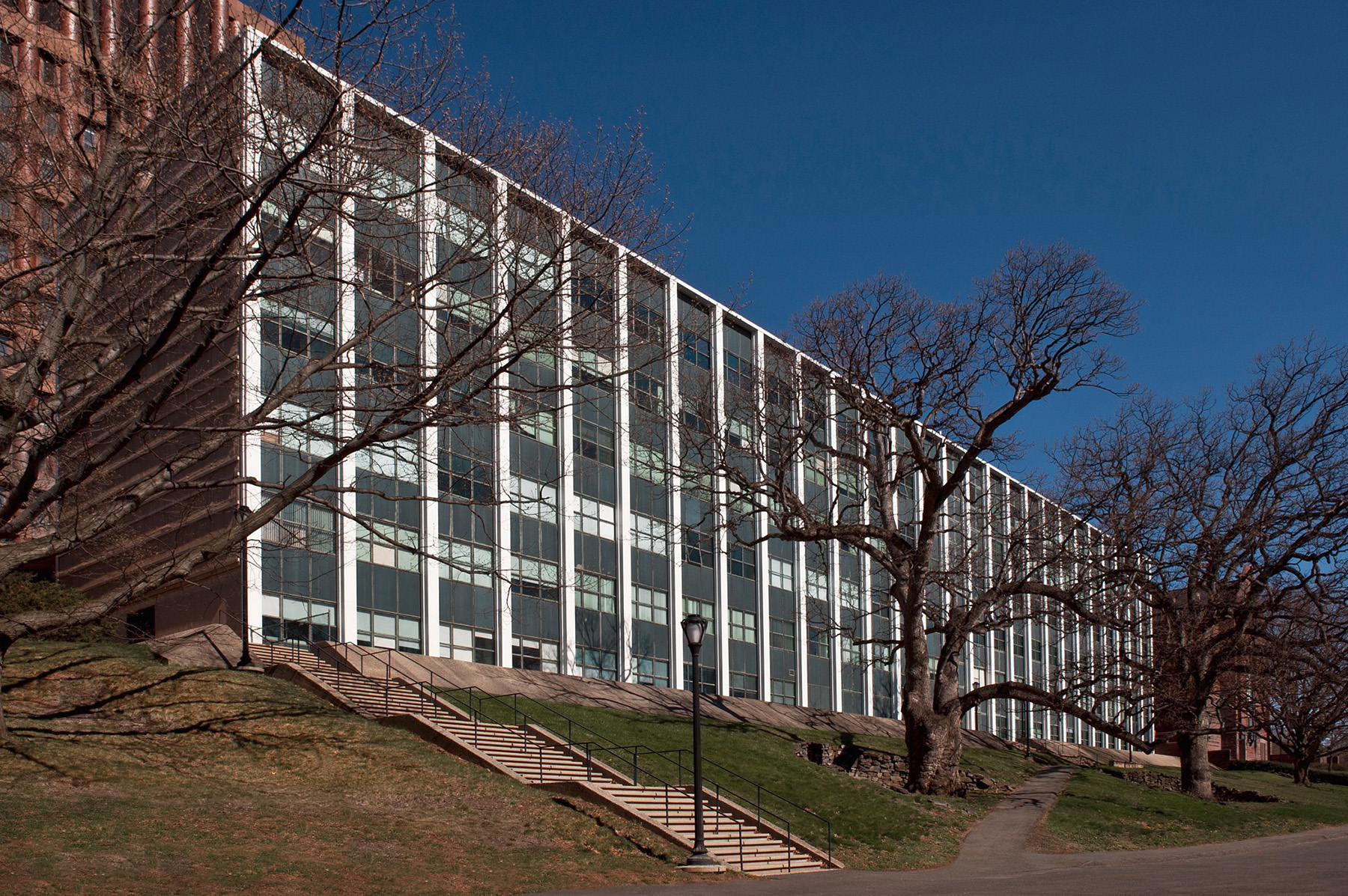
Additionally, Gibbs Laboratory’s bay sizes were incompatible with modern laboratory layouts, limiting its research opportunities, and the mechanical systems needed to be replaced. This constellation of issues, along with aging and practically immovable mechanical systems, severely limited the building’s usefulness.
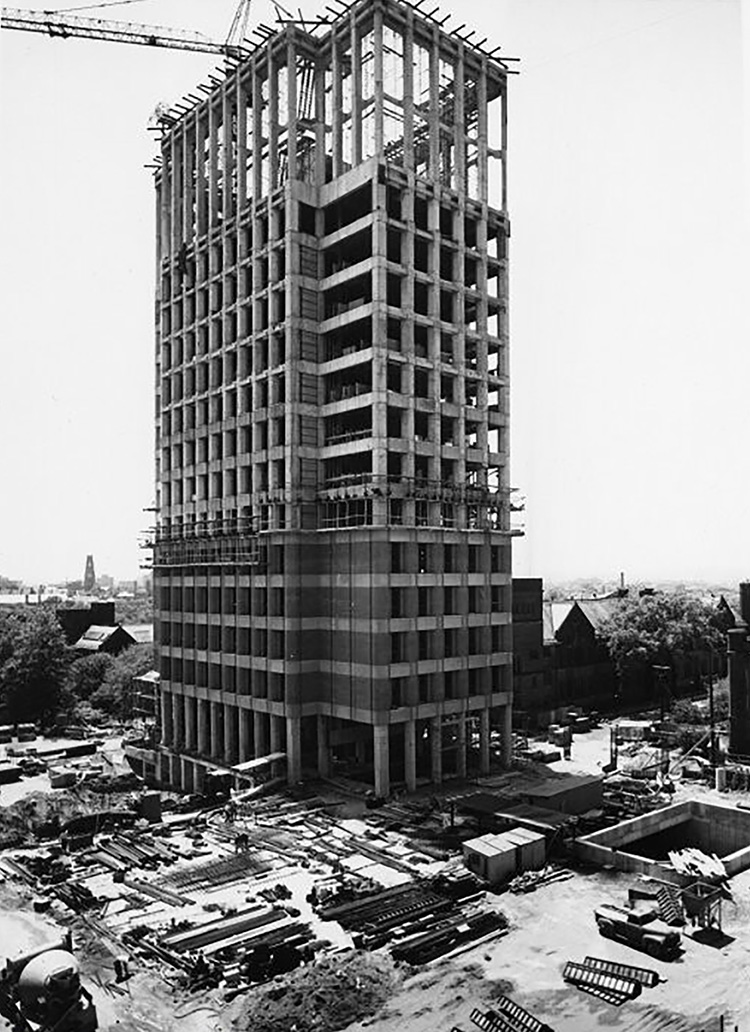
At 16 stories, Kline Tower sits at the top of Science Hill and is the tallest building on campus. In contrast to Gibbs Laboratory and its glass-and-steel facade, the brick-clad Kline Tower was a landmark of Science Hill and a prominent building in the New Haven skyline.
Yale originally dedicated the building to the university’s biology department, as part of its effort to modernize and enhance its research infrastructure. But the tower’s small floor plate and inefficient net-to-gross configuration posed challenges for wet laboratory flexibility and scientific research.
In 2017, Yale demolished Gibbs Laboratory to build Yale Science Building, commonly called YSB, on Science Hill. With an understanding of the university’s needs, YSB was designed and erected to provide modern laboratory spaces that several of the science departments required.
However, unlike Gibbs Laboratory, Kline Tower was still useful. It has been repurposed as a hub for computational research. This transformation has upgraded the historic structure to current campus standards while improving its energy efficiency and sustainability.
Equally important, the renovation maintained the landmark building’s exterior while enhancing its prominence and connectivity.
The new Yale Science Building
YSB is a modern, flexibly planned research laboratory setting that unites three of the biology departments, as well as part of the molecular biophysics and biochemistry departments, the Quantitative Biology Institute, and the physics labs. The building was set into the footprint of the former Gibbs Laboratory. In addition to laboratories, the seven-story, 282,000 sq ft structure houses office spaces, a 500-seat auditorium, an aquatics research center, and a rooftop greenhouse.
To excavate for the foundations, crews line-drilled and stabilized the surrounding bedrock that would remain using rock dowels and shotcrete. The foundation’s spread footings are supported by New Haven Arkose bedrock, which has a high bearing capacity of 10 tons per sq ft. For the bedrock that would be removed within the new building footprint, crews used special mining equipment, eliminating the need for blasting.
The composite steel-framed laboratory floors were designed with 32 ft by 20 ft structural bays to support flexible, state-of-the-art laboratories, each based on a standard 10 ft, 8 in. bench module. Short beams and long girders configured with girders that parallel the building’s length maximize ceiling height by reducing beam depths and provide space for mechanical systems to run along the building’s length. Framing for the laboratory areas achieves the Vibration Criteria A requirement of 2,000 microinches per second under moderate walking speeds.
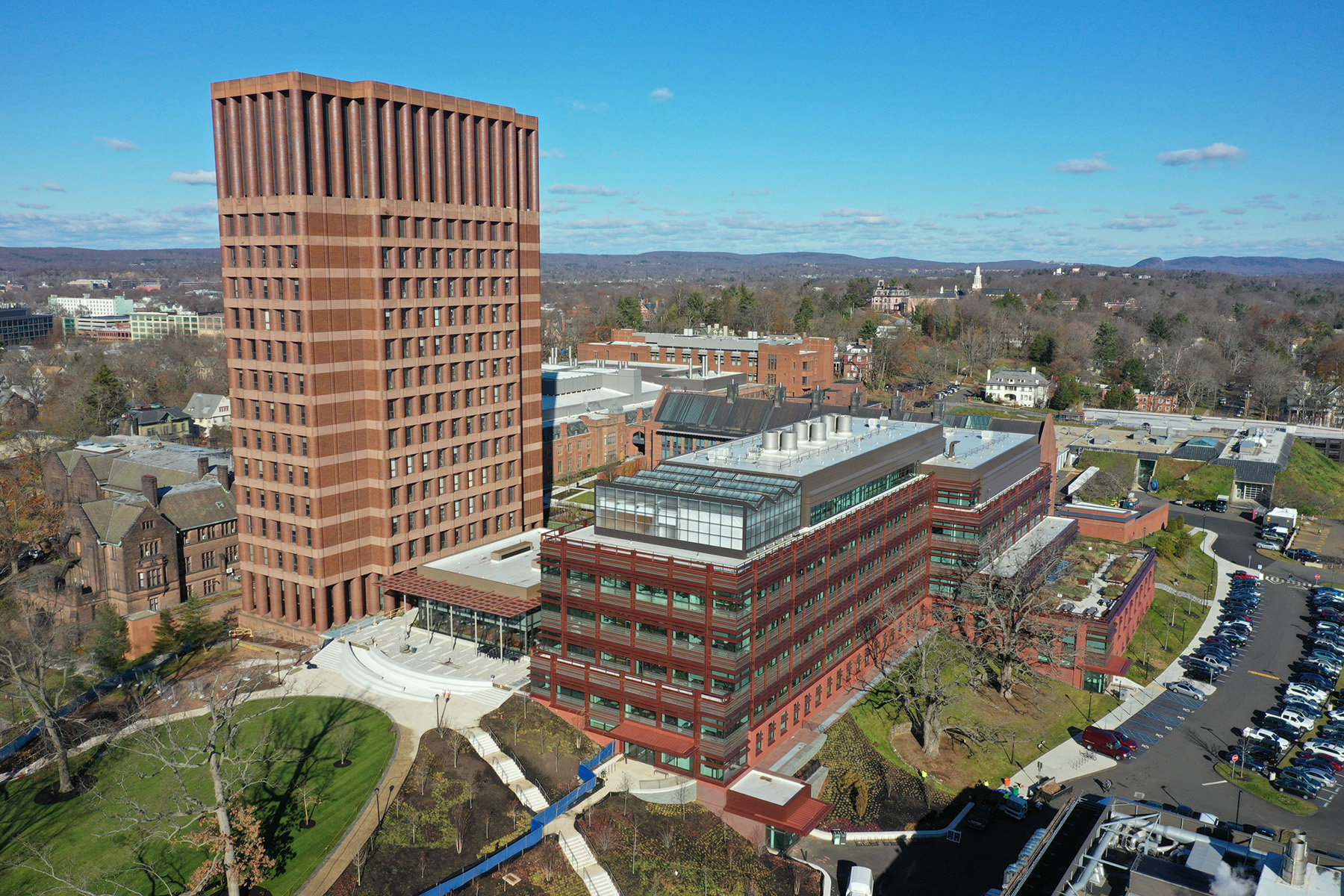
The team designed prefabricated frames for the primary mechanical, electrical, and plumbing systems so that they hang efficiently from the structure. The design team standardized laboratory services, shut-off locations, and future service routing by using prefabricated multitrade racks and risers. This approach enhances maintenance efficiency, provides flexibility for evolving research needs, and extends the building’s functional life while reducing future renovation time and costs. MEP systems were assembled within the prefabricated frames off-site. The frames were then installed on-site as a unit, limiting time for trade partners in the field and reducing overall construction time.
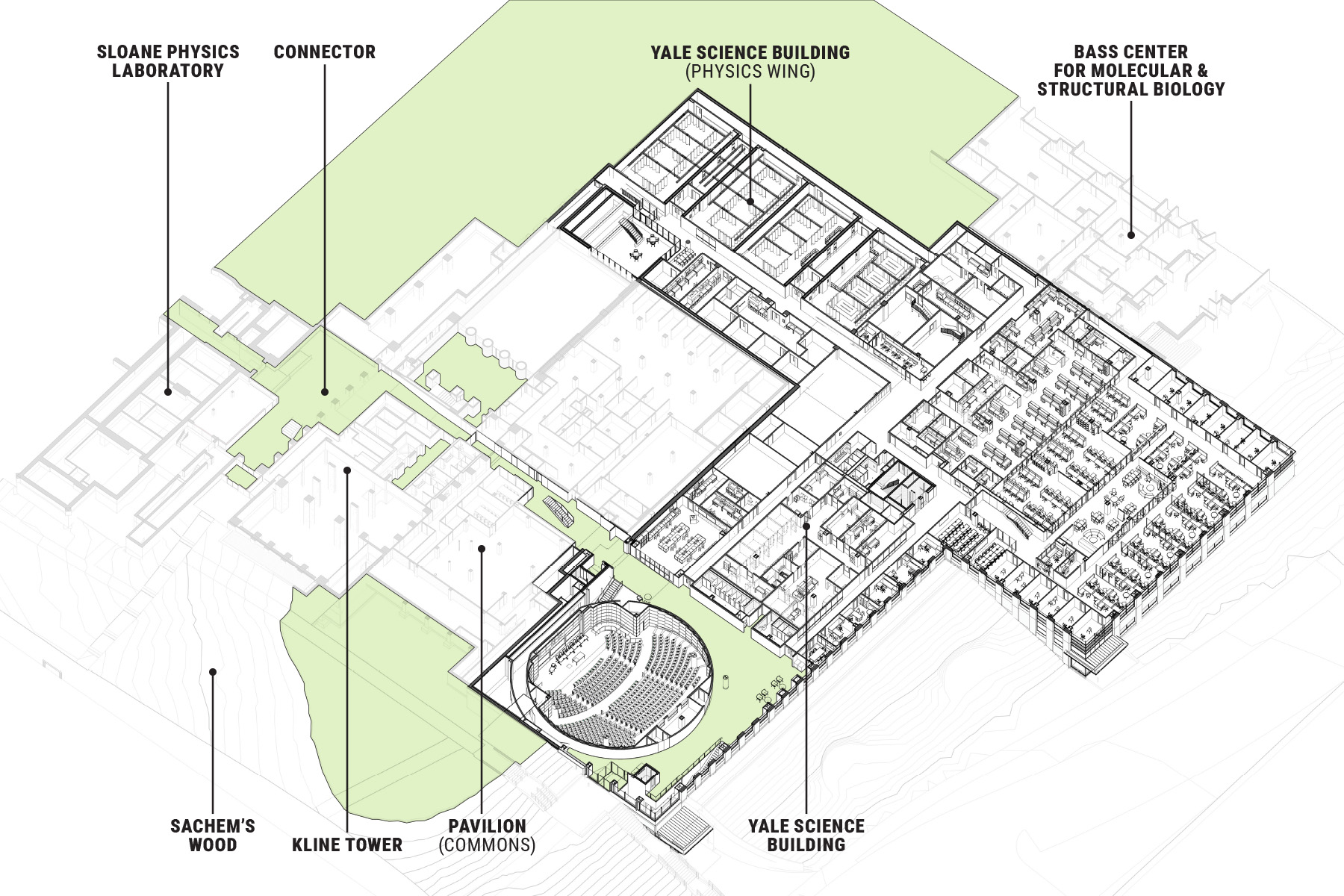
One factor the design team had to account for was the higher vibration performance required for physics research. To accommodate this, the design team strategically isolated the physics spaces from the main building. These spaces are located beneath the courtyard, or Commons, formed by YSB, Kline Tower, Sterling Chemistry Laboratory, and Bass Center.
Slabs are supported on bedrock to ensure the highest vibration control possible. The design team conducted on-site environmental vibration measurements at the bedrock elevation to establish baseline performance for the site. The most sensitive lab equipment requiring more vibration control was installed on plinths in 5 ft deep isolation pits. The roof above the physics wing is structured with 18 in. thick concrete flat slabs that support the landscaped courtyard Commons above.
Kline Tower renovation
The renovated Kline Tower adds features that have transformed it from a research building containing wet laboratories into a hub for Yale’s physical and mathematical sciences. It now houses the departments of astronomy, mathematics, and statistics and data science, along with classrooms, academic offices, a library, and collaboration spaces. The departments are organized into three-floor communities, each with its own offices, collaboration areas, and conference rooms. Connected staircases open into the collaboration spaces to foster connection and learning.
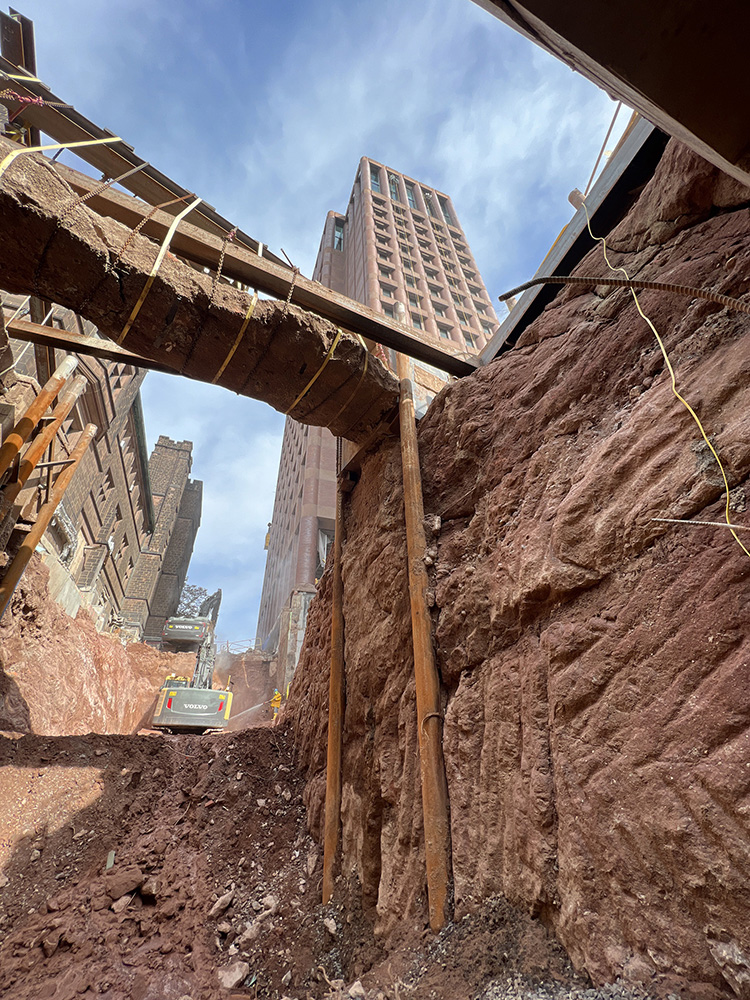
The renovation was classified as a level 3 alteration per the 2015 International Existing Building Code. The original structure consisted of reinforced concrete with slabs spanning to one-way joists. The lateral system included concrete core walls and moment frames.
To limit the scope of major structural upgrades and alterations, the team set programming guidelines to avoid altering vertical load-bearing columns, walls, and elements of the lateral load-resisting system. Since the slab thickness was insufficient to meet the current code fire rating, the team opted for floor slabs protected with cementitious spray fireproofing.
The existing tower connected to the adjacent Sloane Physics Laboratory, a one-story, below-grade structure. To strengthen this connection, crews removed the one-story portion of Kline Tower, lowered its slab, and installed a two-story connector with a landscaped green roof above.
To maximize clear height, the design team limited the framing that supports the plaza between Kline Tower and Sloane laboratory to W14 members for the 35 ft to 45 ft span between buildings.
A one-story 20 ft by 35 ft steel-framed, glass-enclosed connecting walkway was installed between Kline Tower and Sloane at Level 1.
Yale also added another structural connector: Kline Tower to Kroon Hall. Crews built a reinforced-concrete tunnel with a below-grade staircase and elevator connecting to the existing loading dock at the base of Science Hill.
However, the below-grade work presented significant construction challenges, one of which was that a large concentration of critical campus utilities sat between Kline Tower and Sloane and could not be relocated. The second challenge was that existing utilities needed temporary shoring and specialized support during tunnel excavation. Adding to the complexity, excavation revealed previously undocumented utilities that also could not be relocated.
The new elevator, located just 7 ft from the Kline Tower footings, extends more than 20 ft below the bottom of the existing footings, presenting a third challenge. The tower’s footings, supported by bedrock, required special attention to ensure support was not compromised in the temporary or final conditions. Bedrock was line-drilled and carefully removed, and rock anchors were installed to stabilize the bedrock. A higher density of anchors was required in the section adjacent to the tower foundations.
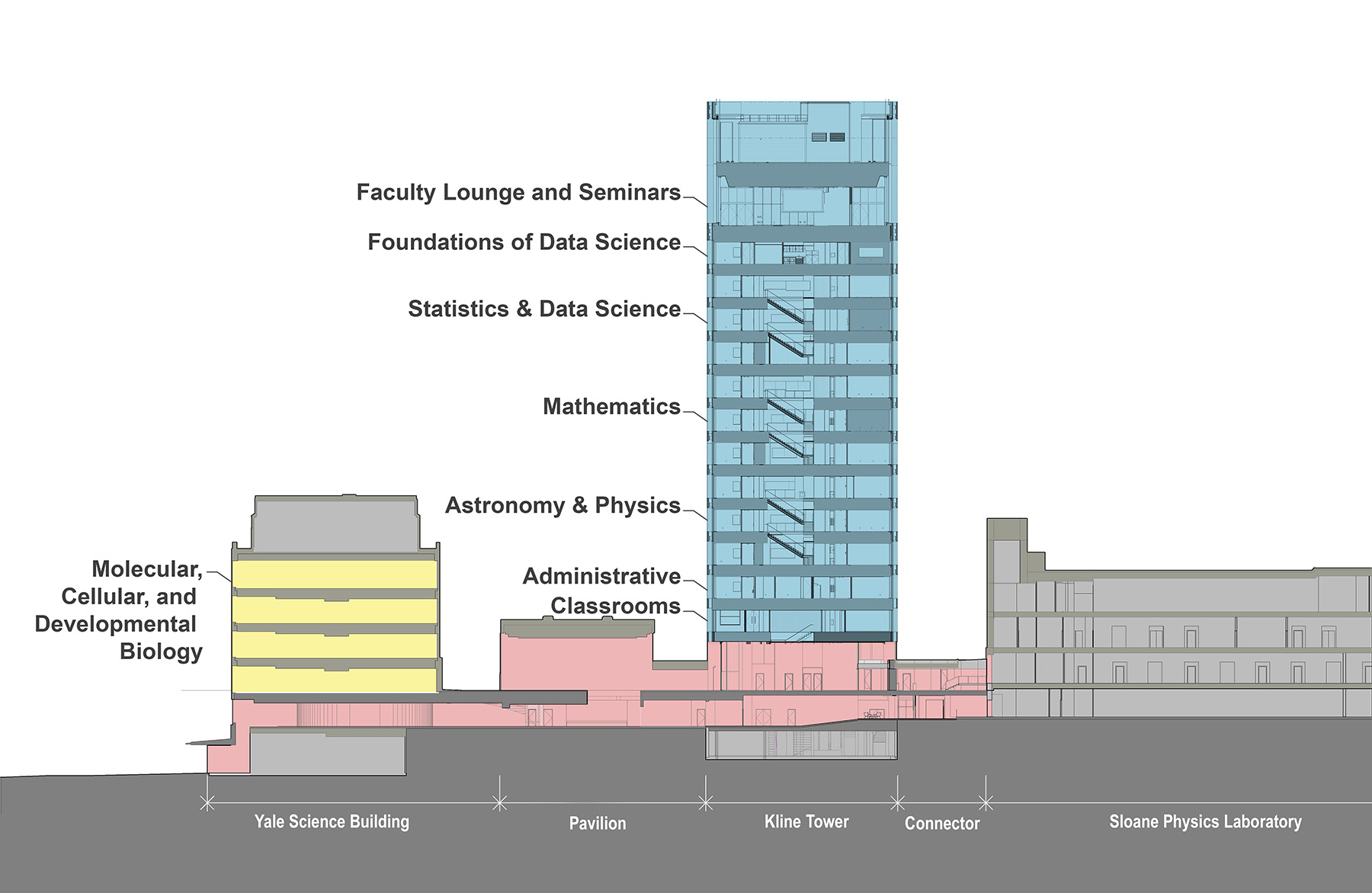
Reassigning Kline Tower’s uses from laboratory to office spaces meant the project team could redesign the building’s mechanical systems. The existing, robust 13th-floor mechanical spaces became the Institute for Foundations of Data Science. The 50 ft parapet that originally concealed rooftop mechanical systems and a reinforced-concrete penthouse — including a tank house, machine room, and mechanical spaces — was scaled back, dramatically reducing the weight of the mechanical systems.

This allowed crews to remove the reinforced-concrete penthouse and in its place add a lightweight metal deck roof and steel roof framing. In place of the penthouse, a 14th-floor event space was added that affords 360-degree views of the campus, all without increasing seismic loads to the building.
The Kline Tower project included sustainability measures to improve the building’s carbon footprint. Reusing the existing structure decreases its embodied carbon so that its emissions are less over its lifetime. Additionally, the team installed higher-efficiency MEP systems, which decrease the building’s expenses and energy needs and improve its long-term usefulness.
Beyond the buildings
The existing Commons, bordered by the Sterling, Gibbs, Kline, and Bass buildings, was empty and underused. Wind funneled up Science Hill, particularly between Kline and Gibbs, making the area inhospitable. A covered, reinforced-concrete colonnade walkway, part of Johnson’s design for Kline, lined the perimeter, with a little-used larger open pavilion at the top of Science Hill. For design architect César Pelli, who once served as dean of the Yale School of Architecture, transforming the Commons and the top of Science Hill was a longtime vision of his to achieve a more connected Science Hill.
A wind mitigation study revealed that blocking the wind between YSB (formerly Gibbs Lab) and Kline Tower would significantly improve occupant comfort in the Commons. So, the team removed Johnson’s colonnade and open pavilion and erected a pavilion between YSB and Kline Tower to serve three purposes: a wind barrier, the public face of Science Hill, and a central, year-round gathering space for the Science Hill community.
The glass-enclosed pavilion is a simple, elegant building with a minimal footprint. The completed structure is 26 ft tall and 86 ft long, featuring exposed steel and a perforated aluminum canopy extending from the roof on all four sides. Exterior columns along the south glass facade echo the Norman Foster-designed Evans Hall to the east. Columns are positioned at the building’s perimeter to create an open, column-free gathering space with views of Science Hill, Hillhouse Avenue, and New Haven.
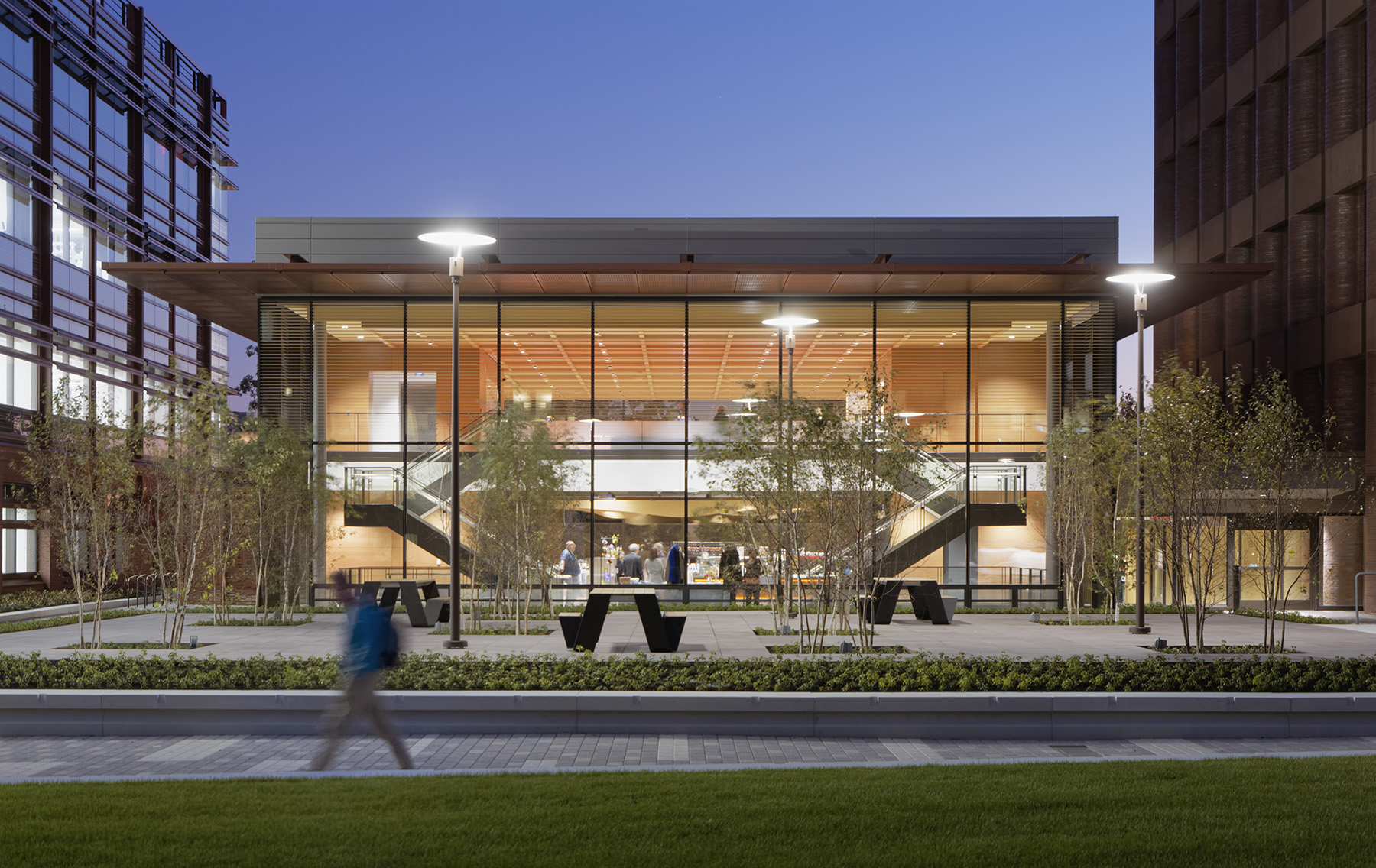
The pavilion was constructed atop the existing one-story section of Kline Tower, requiring columns to thread through the structure and be supported by new footings. The slender eight and five-eighths inch diameter columns are encased in concrete and a Black Rock Fireproof Column to meet fire standards while offering a more refined finish than intumescent paint.
The partial mezzanine at the back of the pavilion overlooks the Commons and is supported by shallow W12 girders spanning the width of the structure. To minimize the size of the typical columns, the design team concentrated the entire lateral load-resisting system in this portion of the building. They originally chose steel-braced frames, but a program change after steel procurement and shop drawing approvals resulted in the removal of the braced frames. The design team’s challenge then was to reinforce the already-procured steel as needed due to the elimination of these frames.
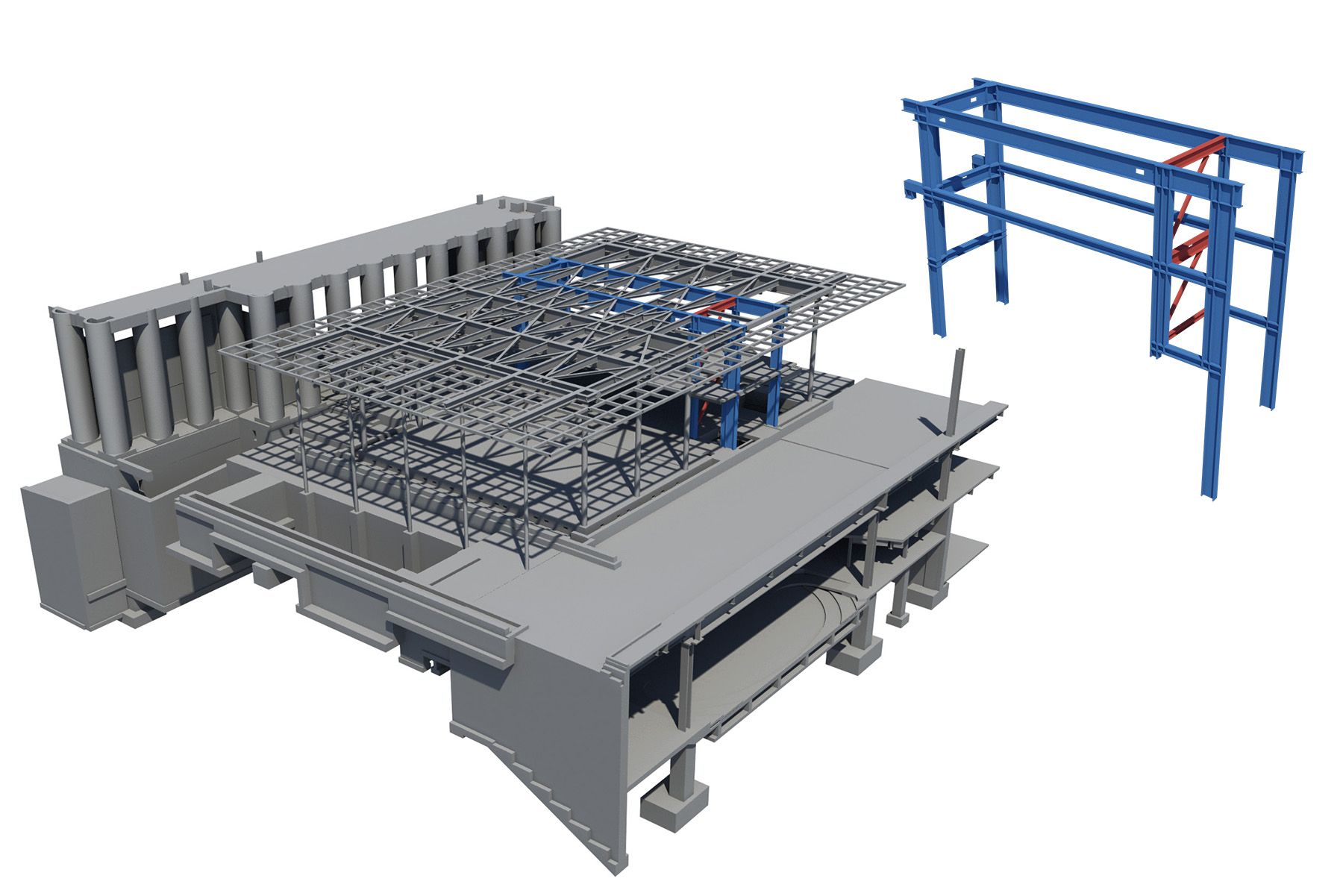
WT sections were welded to steel members along their strong axis, and W27 members were nested between beam flanges to reinforce the weak axis and increase strength and stiffness, converting the system into a moment frame. This required special attention to connection details, particularly where moment frame beams in each direction intersected at nested columns.
Steel cantilevers extend up to 16 ft from the building and are supported by 60 ft long roof girders. To optimize material use, the design prioritized stiffness in the support girders, using heavy W36 sections. This allowed for shallower W12 sections extending the first 12 ft, with underslung hollow structural section 6 in. by 6 in. beams spanning the remainder and framing between to support the preferred panels.
Special attention was given to ensuring the canopy structure remained flat in its final erected condition, with a goal of ±1/8 in. after finished attachment of dead loads. Crews ensured steel framing was preset to accommodate expected deflections. Because girder deflections significantly influenced the final elevation of the cantilevers, coordination between the design and construction teams was strict. The construction sequence included a ballasted roof to account for the weight of the roofing materials and hung ceiling, which was not present during steel erection.
Sachem's Wood
Sachem’s Wood, located on the downward slope of Science Hill and at the head of Hillhouse Avenue, was once a steep and eroded plot of land. The overall project goal was to transform it into a landscaped gateway, featuring a large, ovoid central lawn surrounded by walkways and gently sloped ramps. Today’s layout improves pedestrian flow and ensures accessibility up the hill and into the pavilion. The result is a welcoming, functional, and more social outdoor space that enhances the sense of community on Science Hill and eases the trek from Yale’s main buildings.
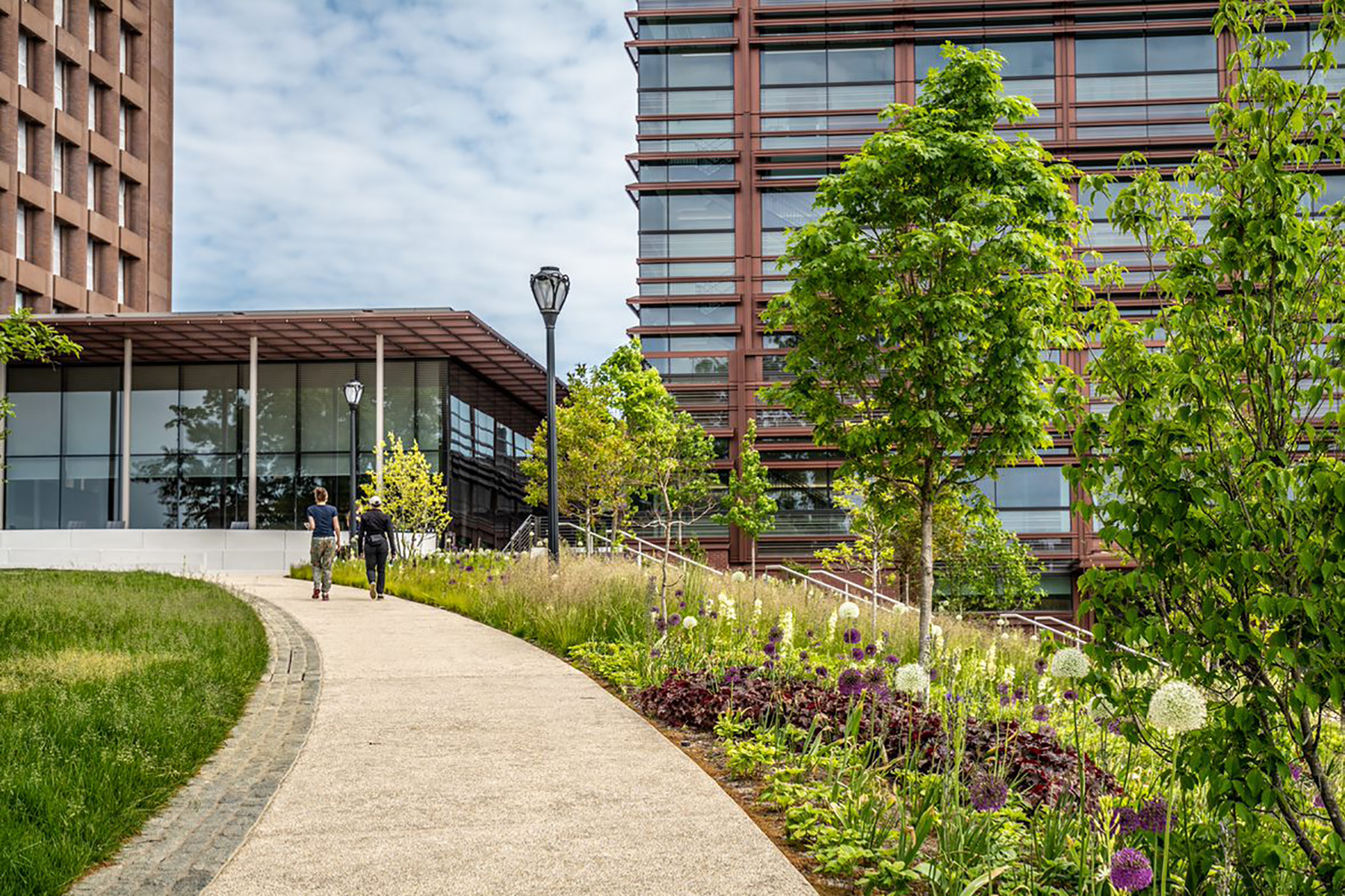
Strolling up Hillhouse Avenue and ascending Science Hill, the iconic American elms that once lined the path have been replaced by oak trees, reflecting another change to this important and historical area of the campus. Just as the landscape has changed, so too has Science Hill. The new YSB and pavilion and renovated Kline Tower showcase Yale’s pursuit of improvement and excellence, ensuring its students carry with them legacies of scientific innovation.
Nathan Roy, P.E., is a principal and Gregory Shreve, P.E., S.E., is a managing principal at LeMessurier. Shawn Maley, AIA, is a principal at Stantec. Sheri Miller, P.E., is senior director of science campus development at Yale University.
Project credits
Owner
Yale University, New Haven, Connecticut
Architect of record
Stantec, Butler, Pennsylvania
Design architect (Yale Science Building and pavilion)
Pelli Clarke & Partners, New Haven, Connecticut
Structural engineer
LeMessurier, Boston
Landscape architect (Yale Science Building)
Reed Hilderbrand, New Haven, Connecticut
Landscape architect (Sachem’s Wood)
James Corner Field Operations, Philadelphia
Geotechnical engineer
Haley & Aldrich, Hartford, Connecticut
Contractor (Yale Science Building, pavilion, and Sachem’s Wood)
Dimeo, New Haven, Connecticut
Contractor (Kline Tower)
Gilbane, Glastonbury, Connecticut
This article first appeared in the November/December 2025 issue of Civil Engineering as “Highlight on the Hill.”






